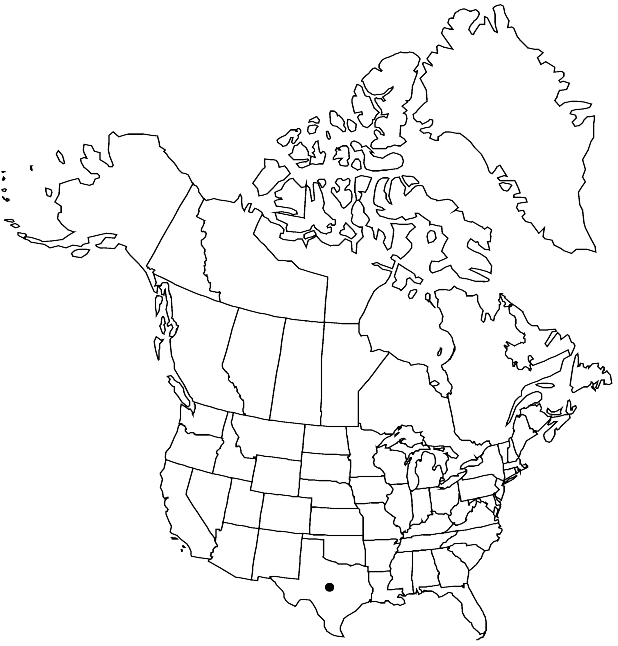Difference between revisions of "Selenia jonesii"
Rhodora 33: 142. 1931.
FNA>Volume Importer |
imported>Volume Importer |
||
| (6 intermediate revisions by 2 users not shown) | |||
| Line 6: | Line 6: | ||
|place=33: 142. 1931 | |place=33: 142. 1931 | ||
|year=1931 | |year=1931 | ||
| + | }} | ||
| + | |special_status={{Treatment/ID/Special_status | ||
| + | |code=E | ||
| + | |label=Endemic | ||
}} | }} | ||
|basionyms= | |basionyms= | ||
| Line 11: | Line 15: | ||
|name=Selenia jonesii var. obovata | |name=Selenia jonesii var. obovata | ||
|authority=Rollins | |authority=Rollins | ||
| + | |rank=variety | ||
}} | }} | ||
|hierarchy=Brassicaceae;Brassicaceae tribe Cardamineae;Selenia;Selenia jonesii | |hierarchy=Brassicaceae;Brassicaceae tribe Cardamineae;Selenia;Selenia jonesii | ||
| Line 26: | Line 31: | ||
|elevation=0-1100 m | |elevation=0-1100 m | ||
|distribution=Tex. | |distribution=Tex. | ||
| − | |discussion=<p>Selenia jonesii is endemic to six counties in the western Edwards Plateau. Variety obovata is reduced herein to synonymy because the alleged difference in fruit shape does not hold; it appears to be an artifact of pressing inflated fruit.</p> | + | |discussion=<p><i>Selenia jonesii</i> is endemic to six counties in the western Edwards Plateau. Variety obovata is reduced herein to synonymy because the alleged difference in fruit shape does not hold; it appears to be an artifact of pressing inflated fruit.</p> |
|tables= | |tables= | ||
|references= | |references= | ||
| Line 35: | Line 40: | ||
-->{{#Taxon: | -->{{#Taxon: | ||
name=Selenia jonesii | name=Selenia jonesii | ||
| − | |||
|authority=Cory | |authority=Cory | ||
|rank=species | |rank=species | ||
| Line 49: | Line 53: | ||
|publication title=Rhodora | |publication title=Rhodora | ||
|publication year=1931 | |publication year=1931 | ||
| − | |special status= | + | |special status=Endemic |
| − | |source xml=https:// | + | |source xml=https://bitbucket.org/aafc-mbb/fna-data-curation/src/2e0870ddd59836b60bcf96646a41e87ea5a5943a/coarse_grained_fna_xml/V7/V7_796.xml |
|tribe=Brassicaceae tribe Cardamineae | |tribe=Brassicaceae tribe Cardamineae | ||
|genus=Selenia | |genus=Selenia | ||
Latest revision as of 22:36, 5 November 2020
Plants winter annuals, (not or rarely subacaulescent). Stems (not inflated into crown), ascending or subdecumbent, (0.5–)1–3(–4) dm. Basal leaves rosulate; petiole 1–2.5 cm; blade margins 2-pinnatisect, 4–8 cm;lobes 4–11 on each side, (smaller than terminal); apical segment linear to oblong or ovate, 1–6 × 0.5–2.5 mm, margins entire. Cauline leaves (and bracts) similar to basal, smaller distally. Fruiting pedicels: some from basal leaf axils, (10–)20–40(–50) mm. Flowers: sepals spreading, oblong, 4–6(–7) × 1.5–2.5 mm, apex appendage developed, 0.5–0.8 mm; petals spatulate, 4–7 × 2.5–4 mm, apex rounded or emarginate; median filament pairs 3–4 mm, not dilated basally; anthers ovate, 1–1.5 mm; gynophore 1–3 mm. Fruits globose or, rarely, obovoid, terete, 0.8–1.5 cm × 8–14 mm, (not fleshy, papery), base usually obtuse, rarely cuneate, apex obtuse; valves obscurely reticulate-veined; replum not flattened; septum complete; ovules 8–14 per ovary; style 1–2(–3) mm, not flattened basally. Seeds 4–5 mm diam.; wing 1–1.5 mm. 2n = 24.
Phenology: Flowering Mar–Apr.
Habitat: Dry lake beds, draws, moist swales, prairie plateaus, playa lakes, buffalo wallows
Elevation: 0-1100 m
Discussion
Selenia jonesii is endemic to six counties in the western Edwards Plateau. Variety obovata is reduced herein to synonymy because the alleged difference in fruit shape does not hold; it appears to be an artifact of pressing inflated fruit.
Selected References
None.
